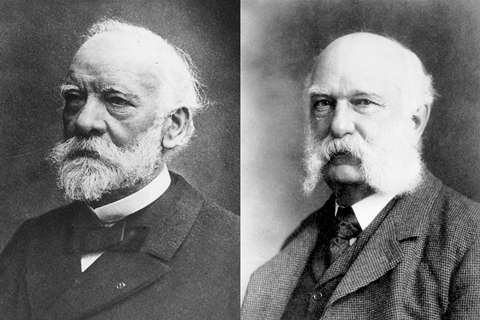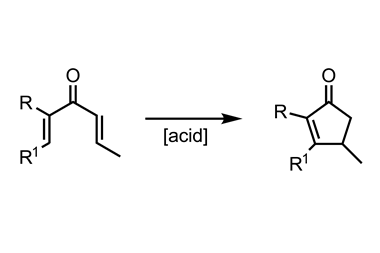The coupling reactions developed by two lifelong friends

In 1932, an affectionate celebration of the life of Charles Friedel was published by Bulletin de la Société Chimique de France to mark the centenary of his birth.1 As a young man, Friedel had been a co-founder of the Société Chimique with Adolphe Wurtz in late 1850s Paris. An undemonstrative and quietly pious man, the centennial article comments that ‘Friedel did not have the eloquence of Wurtz, his voice did not carry’. But Charles Friedel’s voice is still heard, 140 years after his most famous discovery.
Friedel had completed degrees in mathematics and physics at the Sorbonne, and was pursuing mineralogical research at the Museum of Natural History when his interests were diverted towards chemistry by the lively personality and exuberance of Wurtz. Both men were from Strasbourg, proud Alsatians who had attended the same school. Naturally they became friends, and Friedel joined Wurtz’s laboratory at the École de Medecine at the age of 22.2
Friedel’s early work determined patterns of reactivity that established that ketones had similar properties to aldehydes, but he also remained heavily involved with mineralogy and was appointed curator of the mineralogical collection at the École des Mines within two years of beginning his work in organic chemistry. He hesitated to accept the position, aware of the difficulty of balancing the competing demands upon his time,3 but would pursue both fields for the rest of his life. In fact, Friedel’s earliest contribution to published research was a description of a twinned diamond crystal, and he described many new mineral specimens. The first was a zinc/cadmium sulfide blend that he named for his mentor – wurtzite.4
In 1861, a young American arrived to study with Wurtz. Quiet and modest, James Crafts had graduated in chemistry from the Lawrence Scientific School at Harvard. He then moved to Europe to pursue his interest in metallurgy in Freiburg, before continuing his study of chemistry as assistant to Robert Bunsen in Heidelberg.5 In Paris it was quickly apparent that Crafts had similar interests to his new colleague Charles Friedel. The two would become lifelong co-workers and the closest of friends, and they immediately set about their first joint enterprise – to forge a link between their twin passions of organic compounds and minerals. The standard atomic weight of silicon was a point of debate in the early 1860s. Mineral analyses supported a formula of SiO3 for silicates, whereas SiO2 was consistent with the weight and valency of silicon in SiCl4, whose formula was calculated from its vapour density.2 Friedel and Crafts treated SiCl4 with dry ethanol and carefully separated the products by fractional distillation, identifying each by combustion analysis. The atomic weight of silicon was confirmed to be 28, and using diethylzinc instead of ethanol gave SiEt4, the first organosilicon compound (figure 1).6
After four years, James Crafts returned to the United States to work as a mining engineer across the (Wild!) West and California. But his heart lay in research. He soon accepted a position at Cornell, then at the Massachusetts Institute of Technology.
As the Franco-Prussian war intervened across the Atlantic, Friedel moved to his own laboratory at the École des Mines. Provided to support his post of curator of the mineralogical collection, the laboratory had a water supply but no ventilation, and in these surroundings Friedel endured the siege of Paris. His family had left France for the safety of Switzerland, and only when the siege was over did he learn that his wife had died at Montreux. Stricken, Friedel threw himself into supporting the revolutionary government during the Paris Commune – serving in the National Guard and organising the supply of ammunitions.1,7
When James Crafts returned to France in 1874 – with tales of the Frontier – the men would settle to 17 years of uninterrupted work at the École des Mines. On a spring day in 1877, the stagnant air in the laboratory became thick with fuming HCl and gaseous hydrocarbons as aluminium filings led to a turbulent reaction in contact with amyl chloride (C5H11Cl isomers). Rather than vacating the small room, the men reasoned that AlCl3 had formed and was promoting some reaction as yet unknown. So they stayed – to add more AlCl3 and heat the thing up.
From the presence of high boiling products, they realised that acid formation had not occurred solely by elimination of HCl from the alkyl chloride substrate, but also from a coupling reaction. Quickly they sought a controlled cross-coupling and switched to a mixture of benzene and an alkyl halide, refining their method to bring the reaction under control until they were able to prepare toluene very simply, by passing chloromethane into benzene and AlCl3 under gentle heating (figure 2).8 They extended the method to the reaction of benzene with acyl chlorides – and delighted in vivid descriptions of the crystalline forms of the ketone products.9 Friedel–Crafts alkylation and acylation were born.
In 1932, an affectionate celebration of the life of Charles Friedel was published by Bulletin de la Société Chimique de France to mark the centenary of his birth. As a young man, Friedel had been a co-founder of the Société Chimique with Adolphe Wurtz in late 1850s Paris. An undemonstrative and quietly pious man, the centennial article comments that ‘Friedel did not have the eloquence of Wurtz, his voice did not carry.’ But Charles Friedel’s voice is still heard, 140 years after his most famous discovery.
Friedel had completed degrees in mathematics and physics at the Sorbonne, and was pursuing mineralogical research at the Museum of Natural History when his interests were diverted towards chemistry by the lively personality and exuberance of Wurtz. Both men were from Strasbourg, proud Alsatians who had attended the same school. Naturally they became friends, and Friedel joined Wurtz’s laboratory at the École de Medecine at the age of 22. Friedel’s early work determined patterns of reactivity that established that ketones had similar properties to aldehydes, but he also remained heavily involved with mineralogy and was appointed curator of the mineralogical collection at the École des Mines within two years of beginning his work in organic chemistry. He hesitated to accept the position, aware of the difficulty of balancing the competing demands upon his time, but would pursue both fields for the rest of his life. In fact, Friedel’s earliest contribution to published research was a description of twinned diamond crystal and he described many new mineral specimens. The first was a zinc/cadmium sulfide blend that he named for his mentor – wurtzite.
In 1861, a young American arrived to study with Wurtz. Quiet and modest, James Crafts had graduated in chemistry from the Lawrence Scientific School at Harvard. He then moved to Europe to pursue his interest in metallurgy in Freiburg, before continuing his study of chemistry as assistant to Robert Bunsen in Heidelberg. In Paris it was quickly apparent that Crafts had similar interests to his new colleague Charles Friedel. The two would become lifelong co-workers and the closest of friends, and they immediately set about their first joint enterprise – to forge a link between their twin passions of organic compounds and minerals. The standard atomic weight of silicon was a point of debate in the early 1860s. Mineral analyses supported a formula of SiO3 for silicates, whereas SiO2 was consistent with the weight and valency of silicon in SiCl4, whose formula was calculated from its vapour density. Friedel and Crafts treated SiCl4 with dry ethanol and carefully separated the products by fractional distillation, identifying each by combustion analysis. The atomic weight of silicon was confirmed to be 28, and using diethylzinc instead of ethanol gave SiEt4, the first organosilicon compound (figure 1).
After four years, James Crafts returned to the United States to work as a mining engineer across the (Wild!) West and California. But his heart lay in research – and in France. He soon accepted a position at Cornell, then at the Massachusetts Institute of Technology. As the Franco-Prussian war intervened across the Atlantic, Friedel moved to his own laboratory at the École des Mines. Provided to support his post of curator of the mineralogical collection, the laboratory had a water supply but no ventilation, and in these surroundings Friedel endured the siege of Paris. His family had left France for the safety of Switzerland, and only when the siege was over did he learn that his wife had died at Montreux. Stricken, Friedel threw himself into supporting the revolutionary government during the Paris Commune – serving in the National Guard and organising the supply of ammunitions.
When James Crafts returned to France in 1874 – with tales of the Frontier – the men would settle to 17 years of uninterrupted work at the École des Mines. On a spring day in 1877, the stagnant air in the laboratory became thick with fuming HCl and gaseous hydrocarbons as aluminium filings led to a turbulent reaction in contact with amyl chloride (C5H11Cl isomers). Rather than vacating the small room, the men reasoned that AlCl3 had formed and was promoting some reaction as yet unknown. So they stayed – to add more AlCl3 and heat the thing up.
From the presence of high boiling products, they realised that acid formation had not occurred solely by elimination of HCl from the alkyl chloride substrate, but also from a coupling reaction. Quickly they sought a controlled cross-coupling and switched to a mixture of benzene and an alkyl halide, refining their method to bring the reaction under control until they were able to prepare toluene very simply, by passing chloromethane into benzene and AlCl3 under gentle heating (figure 2).[1] They extended the method to the reaction of benzene with acyl chlorides – and delighted in vivid descriptions of the crystalline forms of the ketone products. Friedel-Crafts alkylation and acylation were born.
References
1 A Béhal, Bull. Soc. Chim. Fr., 1932, 51, 1493
2 J M Crafts, J. Chem. Soc. Transactions, 1900, 77, 993 (DOI: 10.1039/CT9007700993)
3 A Willemart, J. Chem. Educ., 1949, 26, 3 (DOI: 10.1021/ed026p3)
4 A Lacroix, Bull. Soc. Chim. Fr., 1932, 51, 1512
5 C R Cross, Biographical Memoirs (National Academy of Sciences of the United States of America), Vol 9, 159, Washington, National Academy of Sciences, 1919
6 C Friedel and J M Crafts, Comptes Rendus Hebd. Seances Acad. Sci., 1863, 56, 590
7 A Boullé, L’Actualité Chimique, 1979, 67, 41
8 C Friedel and J M Crafts, Comptes Rendus Hebd. Seances Acad. Sci., 1877, 84, 1392
9 C Friedel and J M Crafts, Comptes Rendus Hebd. Seances Acad. Sci., 1877, 84, 1450














No comments yet